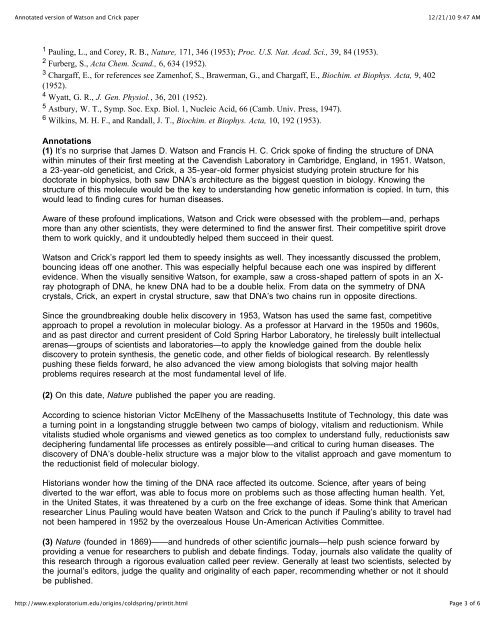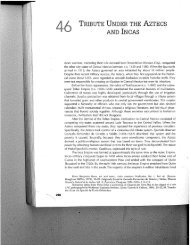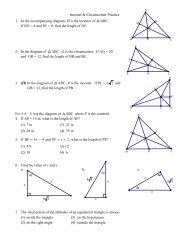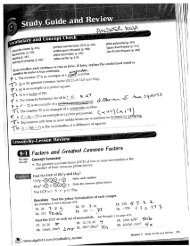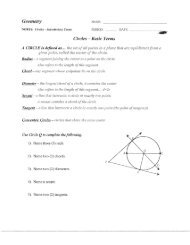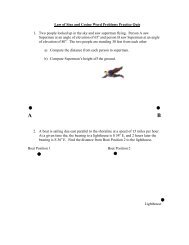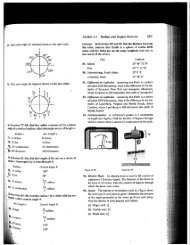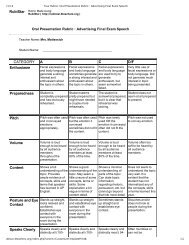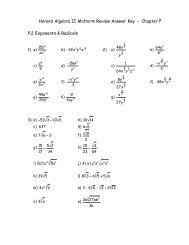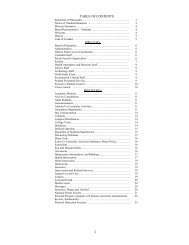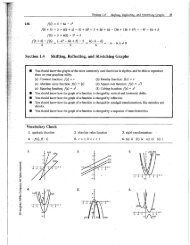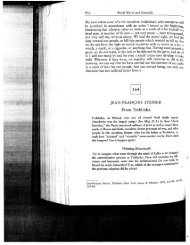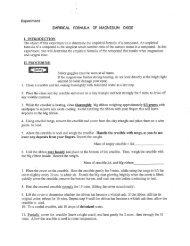Annotated version of Watson and Crick paper
Annotated version of Watson and Crick paper
Annotated version of Watson and Crick paper
- No tags were found...
Create successful ePaper yourself
Turn your PDF publications into a flip-book with our unique Google optimized e-Paper software.
<strong>Annotated</strong> <strong>version</strong> <strong>of</strong> <strong>Watson</strong> <strong>and</strong> <strong>Crick</strong> <strong>paper</strong>12/21/10 9:47 AM1Pauling, L., <strong>and</strong> Corey, R. B., Nature, 171, 346 (1953); Proc. U.S. Nat. Acad. Sci., 39, 84 (1953).2Furberg, S., Acta Chem. Sc<strong>and</strong>., 6, 634 (1952).3Chargaff, E., for references see Zamenh<strong>of</strong>, S., Brawerman, G., <strong>and</strong> Chargaff, E., Biochim. et Biophys. Acta, 9, 402(1952).4Wyatt, G. R., J. Gen. Physiol., 36, 201 (1952).5Astbury, W. T., Symp. Soc. Exp. Biol. 1, Nucleic Acid, 66 (Camb. Univ. Press, 1947).6Wilkins, M. H. F., <strong>and</strong> R<strong>and</strong>all, J. T., Biochim. et Biophys. Acta, 10, 192 (1953).Annotations(1) It’s no surprise that James D. <strong>Watson</strong> <strong>and</strong> Francis H. C. <strong>Crick</strong> spoke <strong>of</strong> finding the structure <strong>of</strong> DNAwithin minutes <strong>of</strong> their first meeting at the Cavendish Laboratory in Cambridge, Engl<strong>and</strong>, in 1951. <strong>Watson</strong>,a 23-year-old geneticist, <strong>and</strong> <strong>Crick</strong>, a 35-year-old former physicist studying protein structure for hisdoctorate in biophysics, both saw DNA’s architecture as the biggest question in biology. Knowing thestructure <strong>of</strong> this molecule would be the key to underst<strong>and</strong>ing how genetic information is copied. In turn, thiswould lead to finding cures for human diseases.Aware <strong>of</strong> these pr<strong>of</strong>ound implications, <strong>Watson</strong> <strong>and</strong> <strong>Crick</strong> were obsessed with the problem—<strong>and</strong>, perhapsmore than any other scientists, they were determined to find the answer first. Their competitive spirit drovethem to work quickly, <strong>and</strong> it undoubtedly helped them succeed in their quest.<strong>Watson</strong> <strong>and</strong> <strong>Crick</strong>’s rapport led them to speedy insights as well. They incessantly discussed the problem,bouncing ideas <strong>of</strong>f one another. This was especially helpful because each one was inspired by differentevidence. When the visually sensitive <strong>Watson</strong>, for example, saw a cross-shaped pattern <strong>of</strong> spots in an X-ray photograph <strong>of</strong> DNA, he knew DNA had to be a double helix. From data on the symmetry <strong>of</strong> DNAcrystals, <strong>Crick</strong>, an expert in crystal structure, saw that DNA’s two chains run in opposite directions.Since the groundbreaking double helix discovery in 1953, <strong>Watson</strong> has used the same fast, competitiveapproach to propel a revolution in molecular biology. As a pr<strong>of</strong>essor at Harvard in the 1950s <strong>and</strong> 1960s,<strong>and</strong> as past director <strong>and</strong> current president <strong>of</strong> Cold Spring Harbor Laboratory, he tirelessly built intellectualarenas—groups <strong>of</strong> scientists <strong>and</strong> laboratories—to apply the knowledge gained from the double helixdiscovery to protein synthesis, the genetic code, <strong>and</strong> other fields <strong>of</strong> biological research. By relentlesslypushing these fields forward, he also advanced the view among biologists that solving major healthproblems requires research at the most fundamental level <strong>of</strong> life.(2) On this date, Nature published the <strong>paper</strong> you are reading.According to science historian Victor McElheny <strong>of</strong> the Massachusetts Institute <strong>of</strong> Technology, this date wasa turning point in a longst<strong>and</strong>ing struggle between two camps <strong>of</strong> biology, vitalism <strong>and</strong> reductionism. Whilevitalists studied whole organisms <strong>and</strong> viewed genetics as too complex to underst<strong>and</strong> fully, reductionists sawdeciphering fundamental life processes as entirely possible—<strong>and</strong> critical to curing human diseases. Thediscovery <strong>of</strong> DNA’s double-helix structure was a major blow to the vitalist approach <strong>and</strong> gave momentum tothe reductionist field <strong>of</strong> molecular biology.Historians wonder how the timing <strong>of</strong> the DNA race affected its outcome. Science, after years <strong>of</strong> beingdiverted to the war effort, was able to focus more on problems such as those affecting human health. Yet,in the United States, it was threatened by a curb on the free exchange <strong>of</strong> ideas. Some think that Americanresearcher Linus Pauling would have beaten <strong>Watson</strong> <strong>and</strong> <strong>Crick</strong> to the punch if Pauling’s ability to travel hadnot been hampered in 1952 by the overzealous House Un-American Activities Committee.(3) Nature (founded in 1869)——<strong>and</strong> hundreds <strong>of</strong> other scientific journals—help push science forward byproviding a venue for researchers to publish <strong>and</strong> debate findings. Today, journals also validate the quality <strong>of</strong>this research through a rigorous evaluation called peer review. Generally at least two scientists, selected bythe journal’s editors, judge the quality <strong>and</strong> originality <strong>of</strong> each <strong>paper</strong>, recommending whether or not it shouldbe published.http://www.exploratorium.edu/origins/coldspring/printit.htmlPage 3 <strong>of</strong> 6


